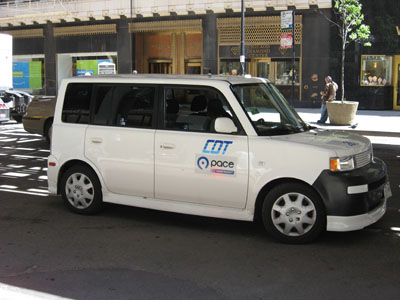Pace estimates it will provide more than 3 million ADA trips on regional paratransit services by 2010 – a 5.8 percent increase from 2007.
Many people around the region are aware of paratransit
services, but do not realize the full range of paratransit services provided
in metropolitan Chicago. Paratransit is a public transportation service available
to individuals with disabilities or health conditions who are
unable to use an established public transportation system. ADA paratransit is
mandated by the federal Americans with Disabilities Act (ADA) to
provide accessible, origin-to-destination transportation service within ¾ of a mile of fixed-route
bus service. “Dial-a-ride” paratransit is not mandated by the federal government,
but is a service offered by transit agencies (such as Pace),
community groups, nonprofits, or the private sector to passengers that travel outside of the federally
mandated service area.

Across the ocean in Finland, the city of Helsinki implemented a
groundbreaking, automated paratransit system in 2006, which uses the
latest technology to provide quality and efficient transportation options to its
paratransit riders. Providing an average of 2,000 trips per day, Helsinki’s
paratransit services work around the clock, 365 days a year, without the need
for dispatchers or schedulers. The automated system operates 60 vehicles and
maintains a reserve fleet of taxis to accommodate periods of high demand. One of
the more innovative tools provided by the automated system is its ability to
reschedule and assign routes. The vehicles are equipped with technology that can
track delays, such as an accident or heavy traffic, in the main scheduling
system. When there is a delay, Helsinki ’s transit agency can dispatch another
vehicle or use its taxi fleet to honor its commitment to its customers.
Helsinki provides over 700,000 trips per year to 12,000 eligible customers.
In 2006, Pace inherited
the responsibility of managing all public paratransit services
in
the Chicago region. Operating the
nation's largest and most expensive paratransit service, Pace provided more than 2.5
million trips in 2007 for more than 40,000 registered passengers,
and maintained a fleet of 358 buses. Pace estimates it will provide
more than 3 million ADA trips on regional paratransit services by 2010
– a 5.8 percent increase from 2007. To accommodate ridership increases
and better manage its regional paratransit services, Pace launched a new
automated system in March 2008, in line with some of the most innovative paratransit
services around the world. While new technology can often create temporary
problems, by mid-May Pace had a 90 percent on-time record, better than any train
or bus fixed-route system in the region.
However, Pace
has a funding shortfall of $61 million for paratransit services in its five-year
capital plan. One of the reasons for the funding gap is due to the reality
that federal funding for ADA paratransit is not available the way it is for
fixed-route services. This funding shortfall needs to be met, otherwise Pace
would be forced to cut service, thereby limiting the options of 40,000 people
who use paratransit in the region.
This article was featured in Talking Transit, MPC’s
bi-weekly e-newsletter. To receive the newsletter, email
talkingtransit@metroplanning.org
with ‘Subscribe’ in the subject line.